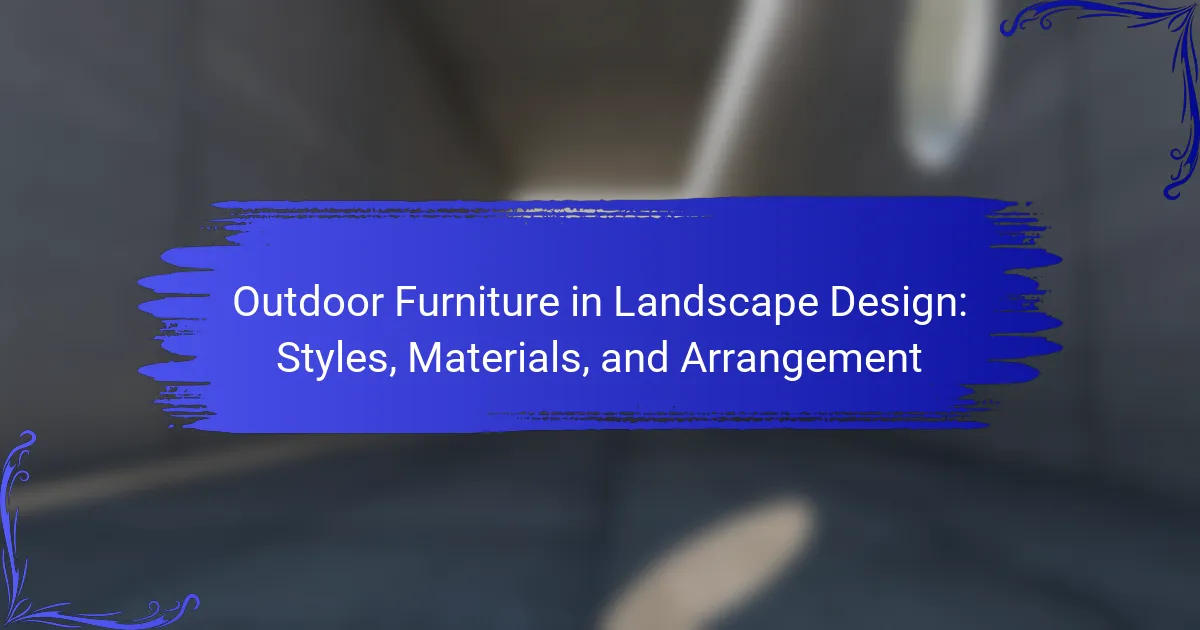Outdoor furniture plays a crucial role in landscape design, encompassing items such as chairs, tables, loungers, and benches specifically made for outdoor environments like gardens and patios. This furniture enhances both functionality and aesthetics, constructed from weather-resistant materials such as wood, metal, and synthetic fibers for durability. Various styles, including traditional, modern, rustic, and contemporary, cater to different design preferences and practical needs. Proper arrangement of outdoor furniture is essential for optimizing usability, promoting social interaction, and ensuring comfort, while also considering elements like sunlight exposure and privacy through natural features.
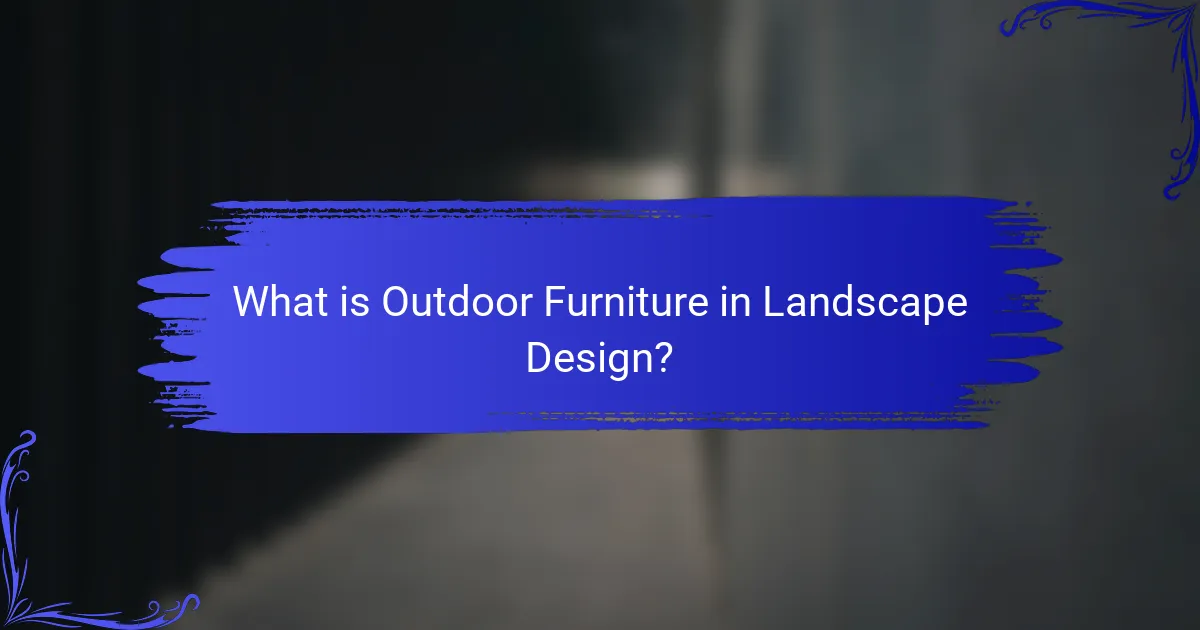
What is Outdoor Furniture in Landscape Design?
Outdoor furniture in landscape design refers to furniture specifically designed for outdoor use in gardens, patios, and other outdoor spaces. This furniture includes items such as chairs, tables, loungers, and benches. Outdoor furniture enhances the functionality and aesthetics of landscape areas. It is crafted from weather-resistant materials like metal, wood, and synthetic fibers. These materials ensure durability against environmental elements. Additionally, outdoor furniture contributes to the overall design theme of a landscape. It allows for social interaction and relaxation in outdoor settings. Studies show that well-placed outdoor furniture can improve the usability of outdoor spaces.
How does outdoor furniture enhance landscape design?
Outdoor furniture enhances landscape design by providing functional and aesthetic value. It creates inviting spaces for relaxation and socializing. This furniture complements the natural elements of a landscape, such as plants and water features. Different styles of outdoor furniture can reflect the overall theme of the landscape. For example, modern furniture can enhance contemporary gardens, while rustic pieces suit natural settings. Materials like wood, metal, and wicker offer durability and style. Proper arrangement of outdoor furniture can define areas within a landscape, guiding movement and interaction. Studies show that well-placed furniture increases the usability of outdoor spaces, making them more enjoyable.
What are the key elements of outdoor furniture in landscape design?
The key elements of outdoor furniture in landscape design include functionality, aesthetics, durability, and comfort. Functionality ensures that the furniture serves its intended purpose, such as seating or dining. Aesthetics involves the visual appeal, aligning with the overall design theme of the landscape. Durability is crucial as outdoor furniture must withstand various weather conditions. Comfort enhances the user experience, making outdoor spaces inviting. These elements collectively contribute to the effectiveness of outdoor furniture in enhancing landscape design.
How does outdoor furniture contribute to the overall aesthetics of a landscape?
Outdoor furniture enhances the overall aesthetics of a landscape by providing functional beauty. It serves as a focal point, drawing attention to specific areas. The design and materials of outdoor furniture can complement natural elements, creating harmony in the space. For example, wooden furniture can blend seamlessly with garden settings. Colorful cushions or fabrics can add vibrancy against greenery. The arrangement of furniture can define spaces, guiding movement and interaction. Additionally, well-placed furniture invites social gatherings, enriching the landscape’s livability. Studies show that thoughtfully designed outdoor spaces can increase property value by up to 20%.
Why is the choice of outdoor furniture important in landscape design?
The choice of outdoor furniture is crucial in landscape design because it influences functionality and aesthetics. Properly selected furniture enhances outdoor living spaces. It creates inviting areas for relaxation and social interaction. Additionally, outdoor furniture must withstand weather conditions. Durable materials ensure longevity and maintain appearance over time. The style of the furniture should complement the overall landscape theme. This coherence promotes visual harmony in the space. Ultimately, thoughtful furniture selection can elevate the user experience in outdoor environments.
What factors should be considered when selecting outdoor furniture?
Durability, weather resistance, comfort, style, and maintenance are key factors to consider when selecting outdoor furniture. Durable materials like teak or aluminum withstand outdoor conditions. Weather resistance protects furniture from rain, sun, and temperature changes. Comfort is essential for enjoyment; cushions and ergonomic designs enhance seating. Style should match outdoor aesthetics and personal taste. Maintenance requirements vary; some materials need regular care while others are low-maintenance. Selecting furniture that balances these factors ensures longevity and satisfaction in outdoor spaces.
How do different styles of outdoor furniture influence a landscape’s design?
Different styles of outdoor furniture significantly influence a landscape’s design by shaping aesthetics and functionality. For instance, modern furniture often features clean lines and minimalistic designs. This style can create a sleek, contemporary look that complements urban landscapes. In contrast, rustic furniture brings warmth and a natural feel, enhancing traditional or garden settings.
The choice of materials also plays a crucial role. Metal furniture can provide a modern edge, while wooden pieces add organic textures. Color schemes in outdoor furniture can harmonize or contrast with surrounding flora, impacting visual appeal.
Furthermore, the arrangement of furniture affects flow and usability in outdoor spaces. Grouping seating can foster social interaction, while strategically placed tables can create focal points. Research indicates that well-designed outdoor spaces increase user satisfaction and engagement.
Overall, the style of outdoor furniture is integral to the overall landscape design, affecting both visual harmony and functional use.
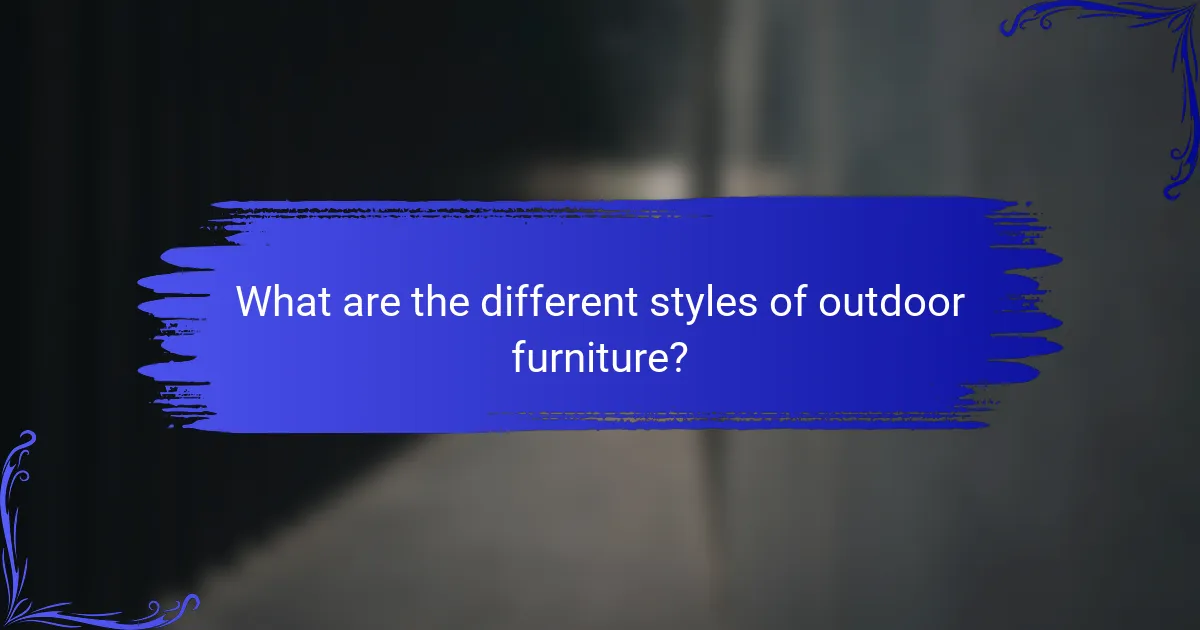
What are the different styles of outdoor furniture?
Different styles of outdoor furniture include traditional, modern, rustic, and contemporary. Traditional outdoor furniture often features classic designs with ornate details. It is typically made from materials like wood and wrought iron. Modern styles focus on sleek lines and minimalism. They often utilize materials such as metal and synthetic fibers. Rustic outdoor furniture emphasizes natural elements and a handcrafted appearance. It is commonly made from reclaimed wood or stone. Contemporary styles blend various materials and designs, often reflecting current trends. Each style serves distinct aesthetic preferences and functional needs in outdoor spaces.
What are the most popular outdoor furniture styles?
The most popular outdoor furniture styles include contemporary, traditional, rustic, and coastal. Contemporary outdoor furniture features sleek lines and modern materials. Traditional styles often incorporate classic designs and intricate details. Rustic furniture emphasizes natural materials like wood and stone, creating a warm, inviting atmosphere. Coastal styles use light colors and breezy designs, reflecting a beach-inspired aesthetic. These styles cater to various preferences and enhance outdoor spaces effectively.
How do traditional and modern styles differ in outdoor furniture?
Traditional outdoor furniture features classic designs with ornate details and natural materials like wood and wrought iron. These pieces often emphasize craftsmanship and historical styles. In contrast, modern outdoor furniture embraces minimalist designs, clean lines, and innovative materials such as aluminum and synthetic fibers. This style prioritizes functionality and comfort over decorative elements. Traditional styles may include intricate carvings and rich finishes, while modern styles often use bold colors and geometric shapes. The shift from traditional to modern reflects changing tastes and lifestyles in outdoor living spaces.
What unique characteristics define rustic outdoor furniture?
Rustic outdoor furniture is characterized by its natural materials and handcrafted appearance. It often features wood, stone, or metal that showcases organic textures. The designs typically emphasize simplicity and functionality. Many pieces are inspired by traditional craftsmanship methods. This type of furniture is usually durable and weather-resistant, suitable for outdoor use. Rustic styles often include elements like rough-hewn surfaces and earthy tones. These characteristics create a warm, inviting atmosphere in outdoor spaces. The appeal lies in its ability to blend seamlessly with natural surroundings.
How can outdoor furniture styles complement various landscape themes?
Outdoor furniture styles can enhance landscape themes by harmonizing design elements and materials. For example, modern furniture with clean lines complements minimalist landscapes. Rustic wood furniture fits well in natural, wooded settings. Wicker furniture adds a casual vibe suitable for tropical or beach landscapes. Metal furniture can provide a sleek contrast in contemporary urban gardens. Color schemes of outdoor furniture can also reflect the surrounding flora, creating visual cohesion. Textures in furniture, such as soft cushions or rough wood, can mirror landscape features like grass or stone paths. Selecting outdoor furniture that aligns with the landscape’s aesthetic ensures a cohesive outdoor experience.
What outdoor furniture styles work best with contemporary landscapes?
Minimalist, sleek outdoor furniture styles work best with contemporary landscapes. These styles emphasize clean lines and simplicity. Materials such as metal, glass, and teak are commonly used. They complement the modern aesthetic of contemporary architecture. Modular seating arrangements enhance flexibility in outdoor spaces. Additionally, multifunctional furniture maximizes usability. For instance, storage benches can reduce clutter. Overall, these furniture styles harmonize with the minimalist design principles of contemporary landscapes.
How does coastal outdoor furniture enhance beach-themed landscapes?
Coastal outdoor furniture enhances beach-themed landscapes by complementing the natural aesthetics of coastal environments. It typically features materials like weather-resistant wood, wicker, and aluminum, which withstand salty air and moisture. These materials also provide a relaxed, inviting look that aligns with beach themes. The color palettes often include soft pastels and ocean-inspired hues, creating a seamless connection with the surrounding scenery. Additionally, the design often incorporates comfortable seating and functional tables, promoting outdoor social interactions. This functionality encourages enjoyment of the beach atmosphere. Coastal outdoor furniture also contributes to the overall ambiance, making spaces feel more cohesive and harmonious with nature.
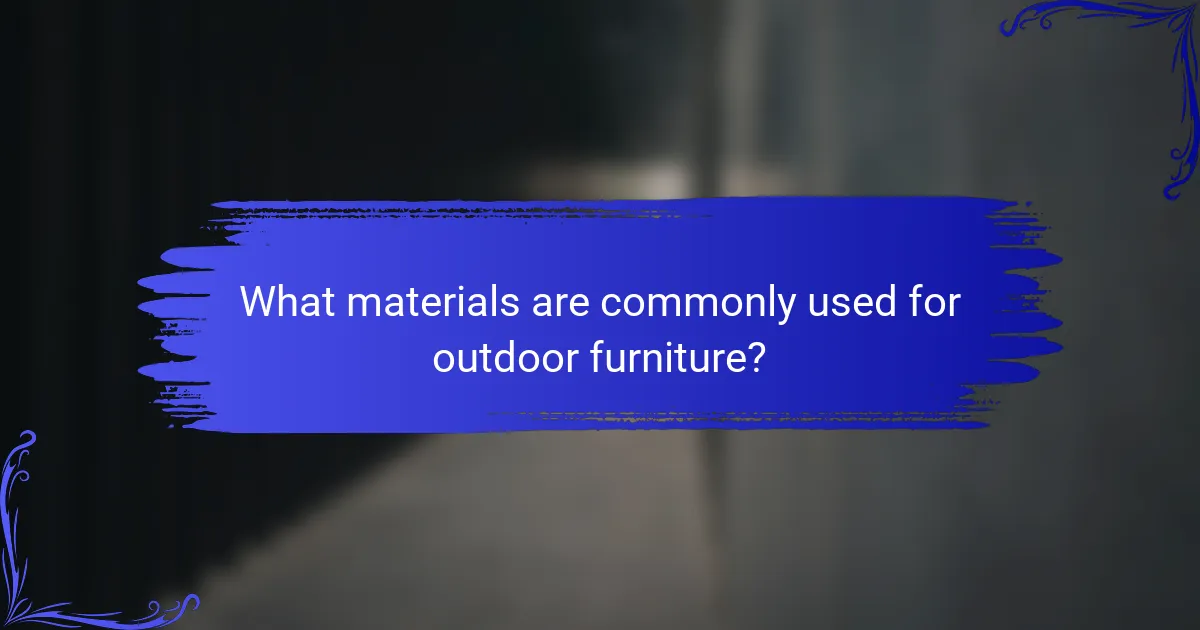
What materials are commonly used for outdoor furniture?
Common materials used for outdoor furniture include wood, metal, plastic, and wicker. Wood, such as teak and cedar, is durable and weather-resistant. Metal options like aluminum and wrought iron offer strength and stability. Plastic materials, including high-density polyethylene, are lightweight and resistant to fading. Wicker, made from synthetic fibers, mimics traditional styles while being weatherproof. These materials are chosen for their ability to withstand outdoor conditions and provide comfort.
What are the advantages and disadvantages of different outdoor furniture materials?
Different outdoor furniture materials have distinct advantages and disadvantages. Wood is aesthetically pleasing and durable but requires regular maintenance. Metal, like aluminum, is lightweight and resistant to rust, yet it can get hot in the sun. Plastic is affordable and easy to clean, but it may not withstand extreme weather conditions. Wicker offers a classic look and is comfortable but can be less durable than other materials. Each material’s performance is influenced by environmental factors, such as humidity and temperature. For instance, teak wood can last decades with proper care, while untreated metal may corrode quickly.
How does weather resistance vary among materials like wood, metal, and plastic?
Weather resistance varies significantly among wood, metal, and plastic. Wood is susceptible to moisture, leading to rot and warping without proper treatment. Untreated wood can last only a few years outdoors. Metal, particularly untreated steel, can rust when exposed to moisture. However, aluminum and stainless steel offer better weather resistance due to their corrosion-resistant properties. Plastic is generally waterproof and resistant to decay, making it suitable for outdoor use. High-density polyethylene (HDPE) is particularly durable and can withstand extreme weather conditions. Overall, plastic tends to have the highest weather resistance, followed by metal, with wood being the least resistant if not treated properly.
What maintenance considerations are associated with various outdoor furniture materials?
Maintenance considerations vary by outdoor furniture material. Wood requires regular sealing or staining to prevent weather damage. Teak, for instance, naturally weathers but benefits from oil treatments for longevity. Metal furniture, such as aluminum, needs occasional cleaning to prevent corrosion. Stainless steel is more resistant but still requires maintenance to keep its shine. Wicker and rattan should be kept dry and cleaned with mild soap to avoid mold. Plastic furniture is low maintenance but should be wiped down to prevent fading. Each material has specific needs to ensure durability and appearance.
How do material choices impact the durability of outdoor furniture?
Material choices significantly impact the durability of outdoor furniture. Different materials have varying resistance to weather conditions. For example, teak wood is known for its natural oils, which provide resistance to moisture and decay. Aluminum is lightweight and rust-resistant, making it ideal for outdoor use. Wicker made from synthetic fibers can withstand UV exposure without fading. Steel, while strong, may require protective coatings to prevent rust. The choice of finish also affects longevity; high-quality sealants can enhance protection against the elements. Research shows that furniture made from durable materials can last over a decade with proper maintenance. Therefore, selecting the right materials is crucial for ensuring the longevity of outdoor furniture.
What materials offer the best longevity for outdoor furniture?
Teak and aluminum offer the best longevity for outdoor furniture. Teak is naturally resistant to moisture, insects, and decay. It can last for decades with minimal maintenance. Aluminum is lightweight and resistant to rust and corrosion. It withstands harsh weather conditions effectively. Both materials maintain their appearance over time. Teak’s natural oils help preserve its quality. Aluminum’s powder-coated finish adds durability. These attributes make them ideal choices for outdoor settings.
How can material selection affect the environmental sustainability of outdoor furniture?
Material selection significantly impacts the environmental sustainability of outdoor furniture. Sustainable materials reduce environmental harm during production and disposal. For instance, using reclaimed wood minimizes deforestation and waste. Materials like bamboo grow rapidly and require less energy to process. Conversely, synthetic materials can contribute to pollution and are often non-biodegradable. The life cycle of materials also matters; durable options reduce the need for replacements. According to the Forest Stewardship Council, responsibly sourced wood can lower carbon footprints. Selecting eco-friendly finishes further enhances sustainability by reducing toxic emissions. Thus, thoughtful material choices promote environmental responsibility in outdoor furniture design.
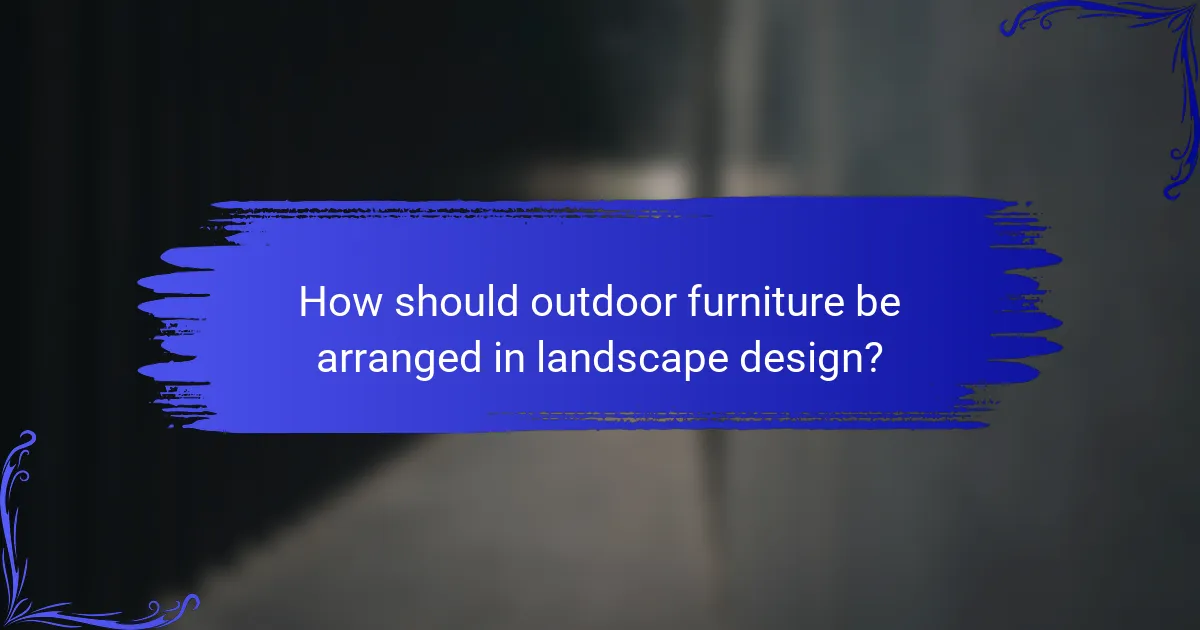
How should outdoor furniture be arranged in landscape design?
Outdoor furniture should be arranged to enhance functionality and aesthetics in landscape design. The arrangement should create defined spaces for activities like dining or lounging. Grouping furniture facilitates conversation and interaction. Positioning seating areas to face each other promotes social engagement. Incorporating pathways between furniture helps with flow and accessibility. Using natural elements, like plants, can create privacy and separation. Ensuring furniture is weather-resistant extends its lifespan and usability. Proper arrangement considers sunlight exposure for comfort throughout the day.
What are the principles of arranging outdoor furniture effectively?
The principles of arranging outdoor furniture effectively include considering functionality, flow, and aesthetics. First, functionality ensures that the arrangement meets the needs of the users. This means placing seating and tables where they can be easily accessed and used. Flow refers to the movement around the furniture. Arranging pieces to allow for easy navigation enhances the overall experience.
Aesthetics involve creating a visually appealing layout. Selecting furniture that complements the surrounding landscape is essential. Additionally, balance in size and scale among the furniture pieces contributes to a harmonious look.
Using these principles leads to a well-designed outdoor space that is both practical and inviting.
How does the arrangement of outdoor furniture impact functionality?
The arrangement of outdoor furniture significantly impacts functionality by influencing accessibility and social interaction. Proper placement allows for easy movement and access to different areas. For example, arranging seating around a fire pit encourages conversation and engagement. Additionally, strategic positioning can create designated zones for dining, lounging, or recreation. This enhances the usability of the space. Research shows that well-planned layouts can improve user satisfaction and comfort. A study by the American Society of Landscape Architects indicates that thoughtful furniture arrangement increases outdoor space enjoyment. Thus, effective arrangement is crucial for maximizing the functionality of outdoor areas.
What role does scale and proportion play in outdoor furniture arrangement?
Scale and proportion are critical in outdoor furniture arrangement. They ensure that the furniture fits harmoniously within the outdoor space. Proper scale means that the size of the furniture corresponds to the dimensions of the area. For example, large sofas may overwhelm a small patio, while tiny chairs can look lost in a spacious garden. Proportion relates to the relationship between different pieces of furniture. For instance, pairing a tall table with short chairs can create visual imbalance. When furniture is arranged with attention to scale and proportion, it enhances functionality and aesthetics. This concept is supported by design principles that emphasize balance and harmony in spatial arrangements.
How can outdoor furniture arrangement enhance social interaction?
Outdoor furniture arrangement can enhance social interaction by creating inviting spaces for conversation. Properly positioned furniture encourages groups to gather and engage with one another. For example, arranging seating in a circular or semi-circular layout fosters inclusivity. This setup allows everyone to see and hear each other easily. Additionally, placing tables within reach promotes shared activities, such as dining or games. Research indicates that comfortable seating increases the duration of social interactions. A study by the University of Illinois found that well-arranged outdoor spaces lead to a 30% increase in social engagement. Thus, thoughtful outdoor furniture arrangement significantly impacts social dynamics.
What are the best layouts for creating inviting outdoor spaces?
The best layouts for creating inviting outdoor spaces include defined zones, comfortable seating arrangements, and natural pathways. Defined zones help establish areas for relaxation, dining, and entertainment. Comfortable seating arrangements encourage social interaction and leisure. Natural pathways guide movement and connect different areas seamlessly. Incorporating greenery and landscaping enhances the aesthetic appeal and comfort. Using varied materials like wood, stone, and textiles adds texture and warmth. These elements collectively foster an inviting atmosphere for users.
How can outdoor furniture be positioned to maximize views and comfort?
Position outdoor furniture to face scenic views for maximum enjoyment. Arrange seating in a way that encourages conversation while providing a clear line of sight to attractive landscapes. Place furniture on stable, level ground to ensure comfort and safety. Use cushions and throws to enhance comfort and invite relaxation. Consider the sun’s path to avoid glare and heat during peak hours. Incorporate shade elements like umbrellas or pergolas to create a comfortable environment. Ensure pathways are clear for easy access to furniture. These strategies enhance both aesthetic appeal and user comfort in outdoor spaces.
What are some best practices for selecting and arranging outdoor furniture?
Select outdoor furniture based on durability, comfort, and style. Choose materials like teak or aluminum for longevity. Consider the climate; materials should withstand local weather conditions. Ensure furniture is comfortable with appropriate cushions. Arrange furniture to promote conversation and accessibility. Allow for adequate space between pieces for movement. Use rugs to define areas and add warmth. Incorporate greenery to enhance the aesthetic appeal.
Outdoor furniture is a crucial element in landscape design, enhancing both functionality and aesthetics in outdoor spaces such as gardens and patios. This article explores various styles of outdoor furniture, including traditional, modern, rustic, and coastal, along with the materials commonly used, such as wood, metal, and plastic. It also discusses key factors for selecting outdoor furniture, including durability, comfort, and weather resistance, as well as best practices for arranging furniture to promote social interaction and usability. Additionally, the article addresses how material choices impact the longevity and environmental sustainability of outdoor furniture, providing a comprehensive overview of its role in landscape design.
